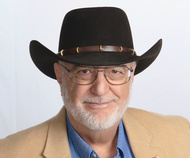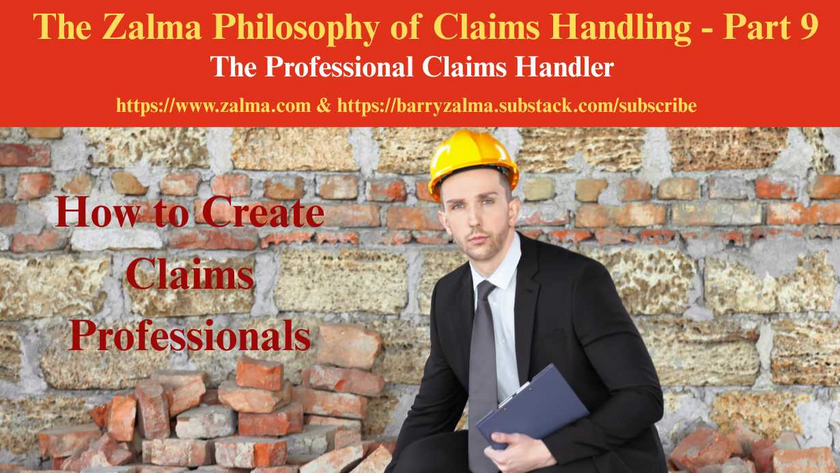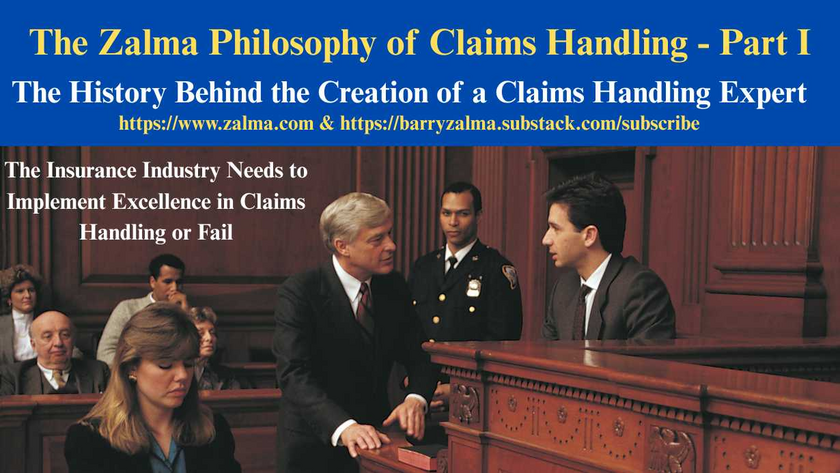
Failure to Fulfill an Insurance Policy Condition Requiring Subcontractors to be Insured Defeats Claim
Read the full article at https://lnkd.in/gxtwYDc3 and at https://zalma.com/blog plus more than 4200 posts.
Posted on April 29, 2022 by Barry Zalma
Russell Blodgett appealed an order of the Superior Court granting summary judgment in favor of the plaintiff, Cincinnati Specialty Underwriters Insurance Company (CSU). Blodgett argued that the trial court erred by concluding that the terms of a commercial general liability policy issued by CSU clearly and unambiguously excluded coverage for Blodgett’s damages in a separate personal injury action against CSU’s insured resulting from Blodgett’s fall from an alleged negligently constructed staircase.
In Cincinnati Specialty Underwriters Insurance Company v. Best Way Homes, Inc., No. 2021-0280, Supreme Court of New Hampshire (April 27, 2022) the Supreme Court read the full policy and resolved the issues raised by the parties.
FACTS
CSU’s insured, defendant Best Way Homes, Inc. (Best Way), is a general contractor. In May 2012, Best Way entered into a contract with a homeowner to perform renovations at his residence (the property). The project included constructing a deck with an attached staircase. Pursuant to an oral agreement, Best Way subcontracted the construction of the deck and staircase to Bob Wood Construction, which completed the project in 2012.
In 2017, the homeowner hired Blodgett to perform plumbing services at the property. Blodgett was injured when the staircase separated from the deck as he was descending it, causing him to fall approximately ten feet and suffer injuries. Blodgett sued alleging claims against the homeowner for negligence and against Best Way for negligent failure to inspect, warn, and remove hazards, as well as a separate claim against Best Way for negligent hiring and supervision. At the time of the injury Best Way was the named insured under the CSU policy, which was in effect from June 29, 2016 to June 29, 2017. The CSU policy covered bodily injuries caused by an “occurrence” that happened during the policy period. The policy also contained an exclusionary provision, which provided:
1.
Section IV – Commercial General Liability Conditions is amended to include the following language:
As a condition to and for coverage to be provided by this policy, you must do all of the following:
Obtain a formal written contract with all independent contractors and subcontractors in force at the time of the injury or damage verifying valid Commercial General Liability Insurance written on an “occurrence” basis …
This insurance will not apply to any loss, claim or “suit” for any liability or any damages arising out of operations or completed operations performed for you by any independent contractors or subcontractors unless all of the above conditions have been met. (emphasis added)
CSU sued for declaratory judgment, seeking a declaration that it had no duty or obligation to defend or indemnify Best Way with respect to Blodgett’s negligence claims. CSU also moved for summary judgment, arguing that Best Way did not obtain a formal written contract from the subcontractor and thus did not satisfy the conditions precedent to coverage set forth in the exclusionary provision. CSU argued that, as a matter of law, the claims against Best Way were excluded from coverage by the unambiguous terms of the exclusionary provision. The trial court granted CSU’s motion for summary judgment.
ANALYSIS
Blodgett does not dispute that Best Way failed to satisfy the requirements for coverage set forth in the policy’s exclusionary provision. Nonetheless, Blodgett argued that the exclusionary provision does not preclude coverage in this case. Blodgett asserted that, based upon the plain meaning of its terms, the exclusionary provision does not apply to negligent acts that occurred before the policy’s effective date. He therefore argues that, because the subcontractor constructed the stairs in 2012 – approximately four years before the policy became effective – the exclusionary provision does not apply in this case.
An occurrence policy, like that issued by CSU, covers all claims based on an event occurring during the policy period. Here, it is undisputed that the CSU policy is an occurrence policy, which covered “bodily injury” or “property damage” that “occur[red] during the policy period.”
In Cincinnati Specialty U/W Ins. v. Milionis Const., 352 F.Supp.3d 1049, 1055 & n.5 (E.D. Wash. 2018) the USDC, interpreted an identical exclusionary provision and concluded it required the insured to meet “three explicit, unambiguous conditions” and noted that the provision was “subject to only one reasonable interpretation” and, therefore, enforced the exclusion.
The Supreme Court interpreted the present tense language in the exclusionary provision as having “no temporal reference” and meaning simply that CSU must have satisfied the preconditions to coverage in order for coverage to apply to the claim. That the conditions precedent employ present tense language does not mean that the exclusionary provision is limited to injuries resulting from the subcontractor’s work performed during the policy’s coverage period. Rather, it merely indicates that the insured must meet the conditions precedent at the time it seeks coverage in order for the policy to cover the damages. Therefore, when considered in the appropriate context, no reasonable person in the position of the insured could have construed the conditions precedent of the exclusionary provision as having a temporal reference.
Moreover, other language in the exclusionary provision not included in the conditions precedent – written in the past tense – indicate that the provision applies to negligent acts committed before the policy’s inception. Specifically, the exclusionary provision states that the CSU policy will not apply “to any loss, claim or ‘suit’ for any liability or any damages arising out of operations or completed operations performed for you by any independent contractors or subcontractors’ unless all of the conditions have been met.” (Emphasis added.)
Accordingly, the Supreme Court concluded that the exclusionary provision unambiguously applied whenever Best Way seeks coverage under the CSU policy, regardless of whether the acts or omissions that caused the damages occurred prior to the policy’s effective date.
As the trial court noted, the Supreme Court has consistently construed the term “arising out of” broadly to mean “originating from or growing out of or flowing from.” Merrimack School Dist. v. Nat’l School Bus Serv., 140 N.H. 9, 13 (1995) (quotation omitted). Ultimately, the damages alleged by Blodgett – his physical injuries – arose from the subcontractor’s allegedly negligent construction of the staircase that led to its collapse. As the trial court observed, there would be no claims against Best Way but for the alleged negligence of the subcontractor. The claims against Best Way – including those based upon its subsequent omissions after the construction of the staircase – flow from the subcontractor’s alleged negligence and establish a causal connection between the subcontractor’s work and Blodgett’s claims against Best Way. Therefore, all claims against Best Way arose out of the work of the subcontractor and the exclusionary provision precludes coverage in the underlying litigation.
ZALMA OPINION
Liability insurance is a risk spreading device. To limit the premiums charged insurers issuing CGL policies transfer the risk they take by requiring a contractor insured to require that each subcontractor maintain insurance protecting the insured contractor. The subcontractor was not insured and did not protect the risk and as a result the insured contractor breached a material condition of the policy and had no insurance for defense or indemnity.
(c) 2022 Barry Zalma & ClaimSchool, Inc.
Barry Zalma, Esq., CFE, now limits his practice to service as an insurance consultant specializing in insurance coverage, insurance claims handling, insurance bad faith and insurance fraud almost equally for insurers and policyholders. He practiced law in California for more than 44 years as an insurance coverage and claims handling lawyer and more than 54 years in the insurance business. He is available at http://www.zalma.com and [email protected].
Subscribe to Zalma on Insurance at locals.com https://zalmaoninsurance.local.com/subscribe.
Subscribe to Excellence in Claims Handling at https://barryzalma.substack.com/welcome.
Write to Mr. Zalma at [email protected]; http://www.zalma.com; http://zalma.com/blog; daily articles are published at https://zalma.substack.com.
Go to the podcast Zalma On Insurance at https://anchor.fm/barry-zalma; Follow Mr. Zalma on Twitter at https://twitter.com/bzalma; Go to Barry Zalma videos at Rumble.com at https://rumble.com/c/c-262921; Go to Barry Zalma on YouTube- https://www.youtube.com/channel/UCysiZklEtxZsSF9DfC0Expg; Go to the Insurance Claims Library – https://zalma.com/blog/insurance-claims-library/
Insurer’s Exclusion for Claims of Assault & Battery is Effective
Post 5250
Read the full article at https://lnkd.in/gBzt2vw9, see the video at https://lnkd.in/gEBBE-e6 and at https://lnkd.in/gk7EcVn9, and at https://zalma.com/blog plus more than 5250 posts.
Bar Fight With Security is an Excluded Assault & Battery
In The Cincinnati Specialty Underwriters Insurance Company v. Mainline Private Security, LLC, et al., Civil Action No. 24-3871, United States District Court, E.D. Pennsylvania (December 16, 2025) two violent attacks occurred in Philadelphia involving young men, Eric Pope (who died) and Rishabh Abhyankar (who suffered catastrophic injuries). Both incidents involved security guards provided by Mainline Private Security, LLC (“Mainline”) at local bars. The estates of the victims sued the attackers, the bars, and Mainline for negligence and assault/battery. The insurer exhausted a special limit and then denied defense or indemnity to Mainline Private Security.
INSURANCE COVERAGE
Mainline had purchased a commercial ...
Marine Insurer May Dispose of Vessel to Avoid Waste
Post 5249
Read the full article at https://lnkd.in/gfn_UHdp, see the video at https://lnkd.in/gDWVccnr and at https://lnkd.in/gv9nsBqk, and https://zalma.com/blog plus more than 5200 posts.
In Western World Insurance Company v. The Estate Of Shawn Arsenault, No. 25-cv-13413-PGL, United States District Court, D. Massachusetts (December 17, 2025) the USDC was asked to resolve a marine insurance dispute after the sinking of the F/V Seahorse, a commercial fishing vessel, off Cape Cod on June 8, 2025. The vessel’s owner and operator, Shawn Arsenault, died in the incident.
Western World Insurance Company issued a hull insurance policy for the vessel. With no personal representative yet appointed for the estate, the insurer cannot determine the proper payee for the insurance proceeds.
The insurer paid for the vessel’s recovery and removal, and the vessel is now with a salvage company, incurring substantial storage fees. The insurer determined the loss is covered under the ...
Marine Insurer May Dispose of Vessel to Avoid Waste
Post 5249
Read the full article at https://lnkd.in/gfn_UHdp, see the video at https://lnkd.in/gDWVccnr and at https://lnkd.in/gv9nsBqk, and https://zalma.com/blog plus more than 5200 posts.
In Western World Insurance Company v. The Estate Of Shawn Arsenault, No. 25-cv-13413-PGL, United States District Court, D. Massachusetts (December 17, 2025) the USDC was asked to resolve a marine insurance dispute after the sinking of the F/V Seahorse, a commercial fishing vessel, off Cape Cod on June 8, 2025. The vessel’s owner and operator, Shawn Arsenault, died in the incident.
Western World Insurance Company issued a hull insurance policy for the vessel. With no personal representative yet appointed for the estate, the insurer cannot determine the proper payee for the insurance proceeds.
The insurer paid for the vessel’s recovery and removal, and the vessel is now with a salvage company, incurring substantial storage fees. The insurer determined the loss is covered under the ...
Zalma’s Insurance Fraud Letter
Read the full article at https://lnkd.in/dG829BF6; see the video at https://lnkd.in/dyCggZMZ and at https://lnkd.in/d6a9QdDd.
ZIFL Volume 29, Issue 24
Subscribe to the e-mail Version of ZIFL, it’s Free! https://visitor.r20.constantcontact.com/manage/optin?v=001Gb86hroKqEYVdo-PWnMUkcitKvwMc3HNWiyrn6jw8ERzpnmgU_oNjTrm1U1YGZ7_ay4AZ7_mCLQBKsXokYWFyD_Xo_zMFYUMovVTCgTAs7liC1eR4LsDBrk2zBNDMBPp7Bq0VeAA-SNvk6xgrgl8dNR0BjCMTm_gE7bAycDEHwRXFAoyVjSABkXPPaG2Jb3SEvkeZXRXPDs%3D
Zalma’s Insurance Fraud Letter (ZIFL) continues its 29th year of publication dedicated to those involved in reducing the effect of insurance fraud. ZIFL is published 24 times a year by ClaimSchool and is written by Barry Zalma. It is provided FREE to anyone who visits the site at http://zalma.com/zalmas-insurance-fraud-letter-2/
Zalma’s Insurance Fraud Letter
Merry Christmas & Happy Hannukah
Read the following Articles from the December 15, 2025 issue:
Read the full 19 page issue of ZIFL at ...
The Professional Claims Handler
Post 5219
Posted on October 31, 2025 by Barry Zalma
An Insurance claims professionals should be a person who:
Can read and understand the insurance policies issued by the insurer.
Understands the promises made by the policy.
Understand their obligation, as an insurer’s claims staff, to fulfill the promises made.
Are competent investigators.
Have empathy and recognize the difference between empathy and sympathy.
Understand medicine relating to traumatic injuries and are sufficiently versed in tort law to deal with lawyers as equals.
Understand how to repair damage to real and personal property and the value of the repairs or the property.
Understand how to negotiate a fair and reasonable settlement with the insured that is fair and reasonable to both the insured and the insurer.
How to Create Claims Professionals
To avoid fraudulent claims, claims of breach of contract, bad faith, punitive damages, unresolved losses, and to make a profit, insurers ...

The History Behind the Creation of a Claims Handling Expert
The Insurance Industry Needs to Implement Excellence in Claims Handling or Fail
Post 5210
This is a change from my normal blog postings. It is my attempt. in more than one post, to explain the need for professional claims representatives who comply with the basic custom and practice of the insurance industry. This statement of my philosophy on claims handling starts with my history as a claims adjuster, insurance defense and coverage lawyer and insurance claims handling expert.
My Training to be an Insurance Claims Adjuster
When I was discharged from the US Army in 1967 I was hired as an insurance adjuster trainee by a professional and well respected insurance company. The insurer took a chance on me because I had been an Army Intelligence Investigator for my three years in the military and could use that training and experience to be a basis to become a professional insurance adjuster.
I was initially sat at a desk reading a text-book on insurance ...














